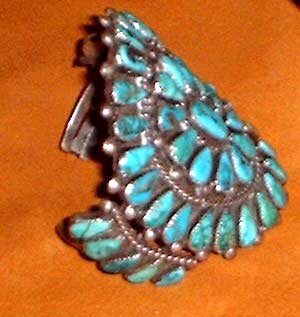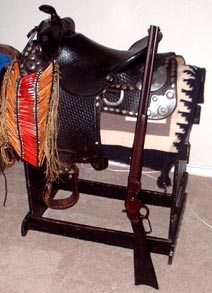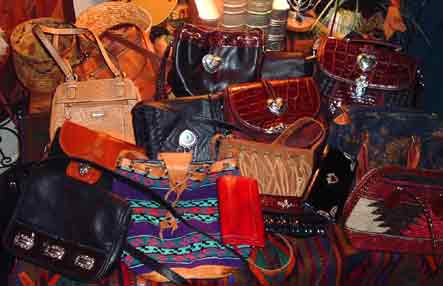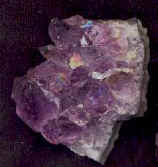

 Typical Taramuhara Native with Classic Drum Used in Religious Ceremonys The Tarahumara Indians of Copper Canyon There is no recorded history of the Tarahumaras prior to the arrival of the Spaniards in the 16th century. So, no one knows how long the Tarahumaras have lived in the Copper Canyon region. Yet, archeologists have found evidence of humans living in the area three thousand years ago. Many of the Tarahumaras still dress in traditional styles. The women and their daughters wear brightly colored multiple skirts, full-sleeved blouses, a headband or bandana and a multicolored shawl for carrying a child or other object on their backs. A few men still wear a breechcloth held together by a wool girdle wrapped around the waist, a cloth headband and a loose cotton shirt. The Tarahumaras live in caves, huts or small cabins, primarily between 7,000 and 9,000 feet elevation. Yet, a few live closer to the canyon floor. The climate varies from arid to tropical and the extremely rugged terrain is a mixture of mesas, valleys and canyon walls. Running up and down the steep canyons is an important part of Tarahumara culture, not only as a means of transportation and communication, but also as a sport between villages. Consequently, the Tarahumaras are world renown for their endurance. Most of the world knows them only as long distance runners. Living in high altitudes, they have developed tremendous lung capacity and in more primitive times hunted deer and mountain goats, running them down on foot. In more modern times, they have run non-stop in relay teams from Chihuahua City to El Paso, a distance of 230 miles, to open the Pan-American Road Races. However, this running ability is only one facet of their life style. The truly remarkable thing about them is an ancient religion which has bred into them a moral code so strict that they are unable to tell a lie. The Spanish invaders in the 1500's gave the name Tarahumara to the Native North American Indians they encountered throughout Chihuahua. The Tarahumara retreated from Chihuahua to the nearly inaccessible mountains and canyons of the Sierra Tarahumara. After mineral wealth was discovered in the mountains, many areas where Tarahumara Indians lived became desirable lands to the miners & mining companies forcing the Tarahumara once again to head deeper into the remote canyons. Today, the Tarahumara are Mexico's second largest native Indian group with a population of approximately 50 thousand people. The Tarahumara are a quiet and considerate people who are expert farmers and runners. Rar�muri has been translated to mean "runners" in their native language. Corn is their main staple along with beans, potatoes, herbs, and apples. Tarahumara Indians also raise goats and cattle and hunt and fish for food. As a source of revenue during lean times, the Tarahumaras make and sell their traditional crafts including pottery, drums and woven grass baskets.  Tarahumara woman weaving a basket. The Tarahumara baskets are known the world around for their high quality. The sale of crafts brings in much needed money for food and medicine. Traditional clothing for the Tarahumara consists of a white cloth shirt, sometimes with colorful prints, white cloth pants or wraparounds with colorful belts or accessories. Headbands of cloth usually red are worn upon the head. Sandals or huaraches are the footwear of choice. The Tarahumara are known for their running skills. Running has always been a tradition and necessity of the Tarahumara. It is their only mode of transportation and many of the small communities are far apart. They also have their own events such as "foot throwing" or Rarj�paro which is a game using a small wooden ball "thrown by the foot" by teams in races that sometimes last for days. The Tarahumara are very religious with two of their festivals being Semana Santa (Easter Week) and the Fiesta Guadalupana in December. These religious rites are a mixture of Christian and Tarahumara beliefs. The Tarahumara Indians also have celebrations at other times such as at the end of harvest time. These celebrations involve tesg�ino, an alcoholic beverage made of corn and grasses that is good only for a couple of days after it is brewed. At these festivals, the Tarahumara Indians will drink until they pass out! Each fall, hundreds of Tarahumara Indians abandon their fields and wooden huts on the high plateaus of the Sierra Madre Occidental in the state of Chihuahua, Mexico, and descend into the many secluded canyons formed by the rivers Urique, Batopilas, Verde, and Conchos -- a continuous canyonland as vast and deep as the Grand Canyon of Arizona. On the upper plateaus, at around 7,000 feet, they tend apple and peach orchards among scraggly forests of ponderosa pines; down in the canyon, oranges and papayas among the yucca and cactus. Their annual migrations take them as much as one mile down, into the depths of the Barranca del Cobre (Copper Canyon) where the milder weather better accommodates their austere way of life.  Copper Canyon (Sierra Madre Occidental) Each spring, they return again, up the steep walls of the canyon, to escape the summer heat. Now famous for their tireless running prowess, the Tarahumara routinely trot up and down the sides of the canyons, hunting, herding goats, carrying goods, or just for fun. The vast ruggedness of the countryside has kept the Tarahumara, and the wild canyons themselves insulated from the influences of modern society. Before the Spaniards arrived in Mexico, Tarahumara communities ranged across the entire area of the northern state of Chihuahua. Throughout the 17th and 18th centuries, they rebelled against Spanish dominion even as their territory shrank back deeper and deeper into the most isolated canyons. As many as 60,000 ethnic Tarahumaras live in northern Mexico. Today many of them stay in permanent communities on the plateaus, or have been assimilated into Mexican towns. But several thousand retain their traditional migratory lifestyle, spending over half the year in the depths of the Barranca del Cobre. A popular contest among the Taramuhara is the rarahipa or kickball race, in which teams from two or more communities each kick a small wooden ball along a set trail winding in and out of the canyons. The ball is kicked ahead to waiting teammates, while others race ahead for the next volly. A short game lasts several hours; more typical are games that go on for a day and a half -- right through the dark of night -- without a stop! And all team members must run the entire race. Various anecdotes attribute the Tarahumara with having shown little interest in competing in international marathon races, because they are "too short". Not as well known, but equally as important in the social lifes of the Tarahumara is the brewing and copious sharing of tesguino, their unique corn beer. While the Tarahumara usually live in small groups of only a few families, the regular tesguinada festivals bring together far-flung communities for days of tesguino drinking, merry-making, contests, and much-needed social interaction. At the bottom of the Barranca del Cobre, deep in Tarahumara country on the banks of the Rio Batopilas, the old copper boom town of La Bufa today counts only 64 souls. Most of La Bufa has been abandoned since the copper days at the turn of the century. The mine shafts are boarded up and the school house all but deserted. Another day's journey down the canyon floor by burro, the newer gold and silver mining outpost of Batopilas still operates despite its isolation. The old jailhouse in La Bufa is now home to a retired American airline pilot who has in turn abandoned the U.S. to mine for gold here. His homemade wooden mining rigs -- based on old Spanish designs -- produce very small quantities of gold, but for five years he has lived the life he enjoys among these wildly beautiful cliffs. There is no electricity in La Bufa, and all communications and supplies come down by the thrice-weekly 'mail truck' from Creel, an all-day journey over a treacherous road cut into the canyon sides. Here in the grandeur and desolation of the rugged canyons, spanning over 25,000 square kilometers, is a world apart. It is a world of up and down, of rocks and cliff sides, iguanas, scorpions, deer, hawks, and snakes; of cactus, yucca, kapok, and agave. The canyon is so narrow here that the river sees only an hour or two of direct sunlight each midday. So the Tarahumara make their homes up higher on the steep sides of the canyon that seem to rise straight up for thousands of feet. It is a dramatic and forbiddingly attractive landscape, brought to life by the Tarahumaras -- bringing corn from between the very rocks, orchards of oranges from hidden mesas, beans, squash, and chilies from little gardens, and herding their goats along the rocky slopes. In the evenings, wisps of smoke can be seen rising from the cliff sides, where Tarahumara have made their winter homes in caves and among rock outcroppings. They have stacked stones around huge rock overhangs to form their homes, and on crude looms set across pits dug into the earth, they weave cloth from black wool. It is a world they have left unchanged for centuries, leaving only their footpaths and the soot of their fires on cavern walls -- and their ready laughter echoing down the canyon walls.  Need Professional Assistance
Need Professional Assistancein Setting Up or maintaining Your Very Own Website? LEONARD KUBIAK's TEXAS HISTORY WEB PAGES Prehistoric History of the Liberty Hill Region Liberty Hill Settlement in the 1850's History of the Liberty Hill Stage Coach Stop (1852) Liberty Hill -Then and Now The Founding of New Liberty Hill (1882) History of Reagan, Texas History of Busksnort and Marlin, Texas History of Reagan, Texas Sam Houston-Early-day Texas History Officers and Men of the Republic of Texas General George Custer Generals Robert E. Lee and U.S. Grant Famous Sam Bass Outlaw Gang Indian Treaty Signed With the Comanches, Kiowas, and Apaches in 1867 Governor John Conally, Another Tall Texan Important Documents of Early-Day Texas Battle of San Jacinto-Victory for the Republic of Texas Army History of Rockdale, Milam County, Texas Military Forts in Early Day Texas History of Cedar Springs, Wilderville, and Rosebud, pioneer communities in Falls County, Texas Blueridge Cemetery Roll, Falls County, Texas History of Bremond and Wootan Wells, Robertson County, Texas Waite (Reagan)Cemetery Listing Blue Ridge (Reagan)Cemetery Listing Hog Island (Reagan) Cemetery Listing Johnson (Reagan)Cemetery Listing Powers/McCaleb(Reagan)Cemetery Listing Historic Liberty Hill Cemetery Listing. Kosse History and Home Page. Old 300 Anglo Settlers in Texas. Highbank, Falls County, Texas Home Page. Liberty Hill, Williamson County, Texas Home Page. For more history links, see Complete Listing of Len Kubiak's History Links.   SCHOOL AND TOUR GROUP LIVING HISTORY TOURS On an appointment basis, we conduct living history tours for school children and other history-minded tour groups (we like to limit the size of each tour group to 30, or less). We can take you back into the 1800's with a log cabin filled with primitive tools, tour a dirt-floor museum barm filled with relics of a bygone era. We can also take you back thousands of years and chip and use flint tools, grind grain, make primitive weapons and talk about life in the region before the coming of the Europeans. We also have an abundant collection of native fossils dating back 90 to 120 million years ago when the area was a shallow sea home to mossasarus (swimming dinasaurs), giant sharks, ammonites, and other ancient critters. BIRTHDAY AND REUNIONS You might also keep Fort Tumbleweed in mind for that next birthday party or family reunion. For more information on the history tours, see: Information about Fort Tumbleweed History Tours
 Return to the Fort Tumbleweed Home Page
Return to the Fort Tumbleweed Home Page
| ||




















